Pokémon is a titan of 90s media brands. Globally, the franchise’s market size exceeds 6 trillion Japanese yen, and the 2016 launch of mobile app Pokémon Go virtually doubled Nintendo’s stock prices overnight. After 20 years, The Pokémon Company International is in the midst of a nostalgia-fueled renaissance. While video games remain the staple of the brand’s profit, merchandise is another lucrative asset. The most common item purchased?

Dolls.
Pokémon doll collecting remains a massively popular hobby, with active communities on Livejournal, Reddit, and other social media platforms. This has generated, of course, a stream of counterfeit merchandise. That knock-off Espeon might be cute, but it does have negative impacts on the broader fanbase, as PokeVault.com’s Brian Grabow explains:
“When someone buys a knock-off,” he reported earlier this year, “it hurts the Pokémon Center and Nintendo’s sales, so they end up raising prices to make up for lost revenue. Due to the increased number of imitations, they’ve also raised prices. Some items have more than doubled in price.”
If you’re a collector, there are a few things you can do to ensure you’re buying authentic plush, and thereby supporting creators.
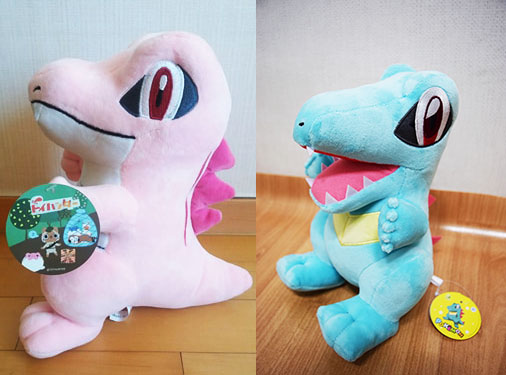
We all remember the pink Butterfree, but...
TIP #1: Identify which of the four types of plush you’re purchasing. There are four categories your plush may fall into – licensed merchandise, counterfeit, factory reject, or fanmade. The first category is straightforward; this licensed merchandise is what you can expect to find in large retail stores. Quality can vary greatly, with Walmart and Target selling mass-produced dolls that are often made of coarser material. On the other hand, dolls sold at official Pokémon Centers tend to have ultra-soft material, high-quality stitching, and extreme attention to detail. Take this “Liberty Pikachu” doll, which was part of the 2016-2017 Around the World campaign:
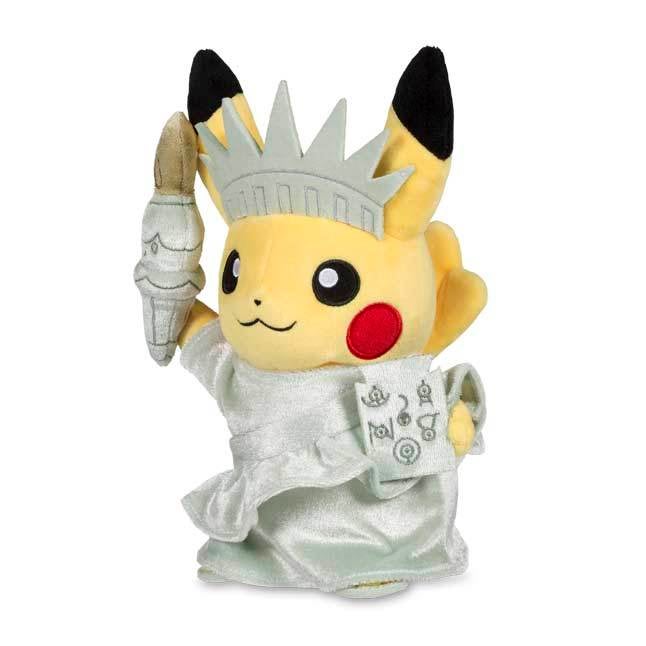
The torch is in the shape of a Litwick, the tablet she holds is emblazoned with Unwon, and her tail is heart-shaped, indicating that we’re specifically looking at a female Pikachu. This is a level of detail rarely seen in fake products.
If you bought a suspiciously cheap doll from eBay, however, you may have purchased a counterfeit. This second category is, unfortunately, extremely common on sites like Amazon and eBay. They’re adorable, yes, but they’re also illegal, and there’s no guarantee they’ve passed through safety protocols. South Korea alleges that half a million counterfeit Pokémon dolls seized at customs were contaminated with harmful chemicals.
The third category, factory rejects, is a bit different. These dolls look authentic, but have small defects that made them fail quality control procedures. An example would be this Alolan Marowak, which has an elongated neck, an incorrectly cut tag, and discolored fabric on its tail. The authentic 2016 Alolan Marokwak doll can be seen here.

Close, but not quite – a factory reject Alolan Marowak
Finally, fanmade toys are in a class all their own. Type any Pokémon character’s name into Etsy.com, and you’ll find these. Fan creators are bona fide artists, and they’re dedicated to enriching the Pokémon fanbase. These individuals aren’t flooding eBay with knock-off toys in a large-scale money grab. Rather, they’re creating a one-of-a-kind piece of art, such as the work of Guardian Earth Plush. These creations are something a Nintendo executive would be delighted to see.
The artist behind Guardian Earth commented: “I generally only make plush that are not available to consumers, as I support the Pokémon franchise official products myself...I also make oversized and poseable plush, as Nintendo does not make these for all Pokémon. I think custom plush makers only enhance people's love for their favorites.”
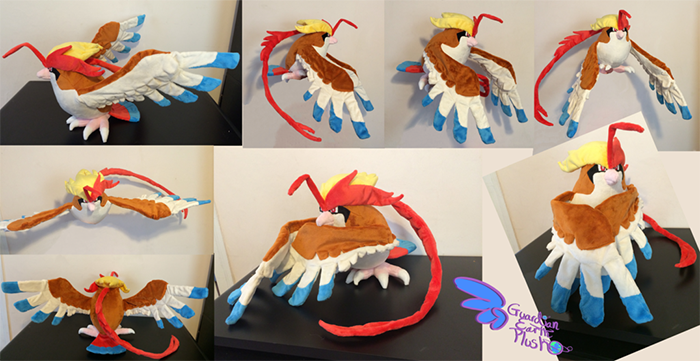
This large, possible Mega Pidgeot plush features a character that never got an officially licensed doll.
Once that you’ve identified what type of doll you’re holding, consider its level of craftsmanship. The Pokémon Company, in its own words, “...has received hundreds of thousands of [licensing] proposals, and we carefully review each one...we consider our licensees to be important business partners. We require that licensees perform end-to-end quality control.” In other words, craftsmanship matters. That’s true in doll culture around the world, whether your product is mass-produced or part of a Hanji paper doll museum.
With this in mind...
TIP #2: Consider how the plush “sits.” Most of the time, officially-licensed toys will sit upright on their own. This isn’t always true, as with the 2017 Halloween campaign Mimikyu, but they are designed with balance in mind. Ears, fins, and spikes should stand up straight.
TIP #3: Consider the quality of the stitching. Are all the lines even? Do all of the seams fit together neatly? Are details painted on and cracking due to wear, or are they actually sewn into the fabric?
These two Vaporeon are a perfect example of quality stitching and “sit.” Can you tell which is counterfeit?
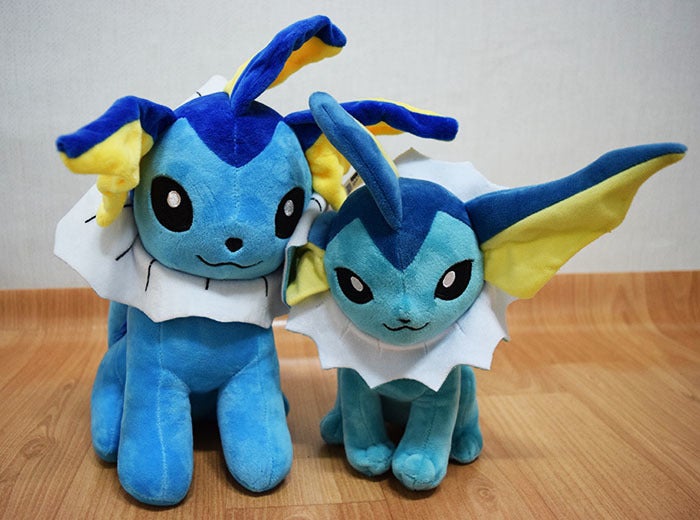
The Vaporeon on the left is a knock-off. The doll the right is officially licensed by Third Round, a subsidiary of Noori Toys.
Notice the fake’s droopy fins, absence of toes, and lines painted (rather than stitched) onto its neck fin. These are tell-tale signs that the product is counterfeit.
TIP #4: Examine the swing tag. During production, every factory is given a set number of swing tags (attached with that funny “T”-shaped plastic) for the dolls. Warning signs include dull, faded colors, misspelled words, and a circular tag, which is very easy to replicate. This Zoroark, while it has clean stitching, has a generic knock-off tag attached.
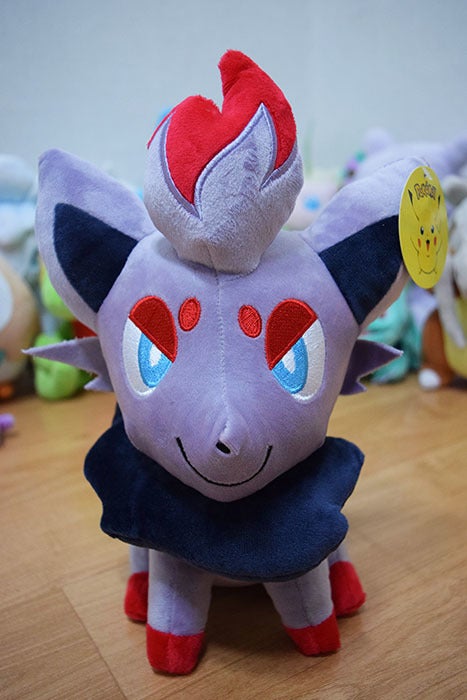
A Zorua plush that is likely ripped off the San-Ei “All Star” line from 2016. Notice the generic, easily-replicated tag.
TIP #5: Examine the copyright tag stitched to the bottom. Just because it says “Pokémon Center” doesn’t mean the item you’re holding is legitimate. Is the text faded or lopsided? Does it contain spelling errors? Is one side in Japanese and the other side in Chinese? These are all warning signs that you may have a counterfeit doll.
TIP #6: Beware sloppy overall design. This Espeon has several loose strings and an off-center nose. On the back of the plush, there’s visible hot glue. This gives a sloppy appearance that would have gotten it pulled from store shelves.
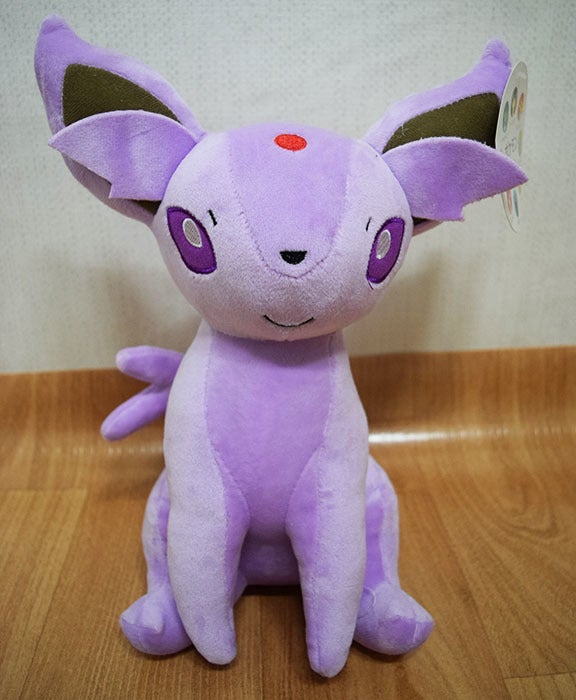
The Eeveelutions, such as Espeon, are among the most commonly counterfeited characters.
TIP #7: Don’t purchase anything that’s bleeding cotton stuffing. Rips and tears suggest that the item you’ve purchased is a factory reject. Sure, they might be from the same production line as genuine merch, but many of these dolls were illegally stolen out of the trash.
TIP #8: Know that the “Pokédoll tag” is the most commonly copied. South Korea’s arcades are flooded with knock-off merchandise that boast this tag, which actually hasn’t been in use since 2007. Often, the pennant-style tag will be off-color, slightly faded, and bent. An example is this Venusaur, won from a crane machine in Seoul’s Sinchon district:
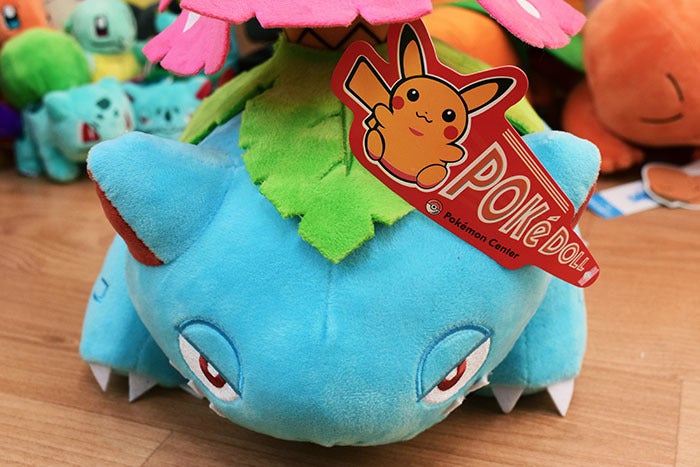
TIP #9: If you’re buying a plush online, check which country the seller is registered in. In 2017, many Pokémon Center dolls were manufactured in the Philippines or Vietnam, but sold only in Japan. Pop-up stores in South Korea sold them as well, but with a Korean-language sticker on the tags. PokeVault.com explains that most knock-offs originate from China or Hong Kong, where counterfeiters have easy access to design patterns or defective product.
TIP #10: Before buying a plush, do a Google search. There are plenty of collecting communities present online, so use them! A quick Google search of the character’s name and “plush” should bring fourth several results. Does your doll look extremely similar to the ones found on PokemonCenter.com, or is it closer to a suspiciously cheap one on eBay? A quick comparison can save you anywhere from $10 to $100. Brian Grabow’s Umbreon comparison video and guide to tags are also valuable resources for mindful fans.
Whether you’re a veteran collector or new to the fanbase, these tips can help you safeguard the quality of your collection while supporting the creators of the franchise you love. Happy hunting!
